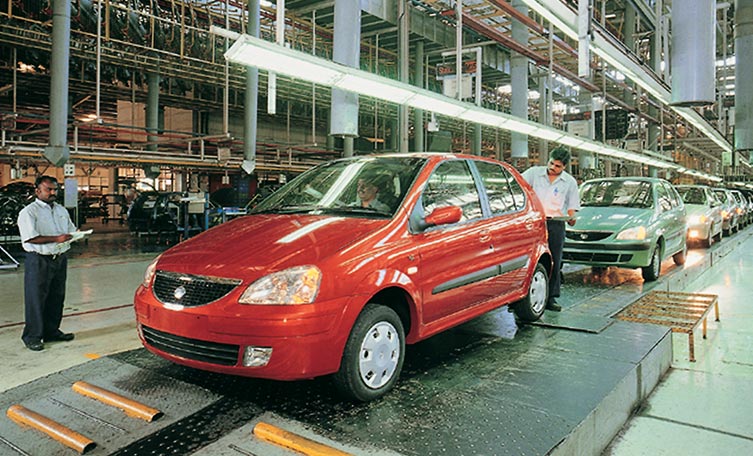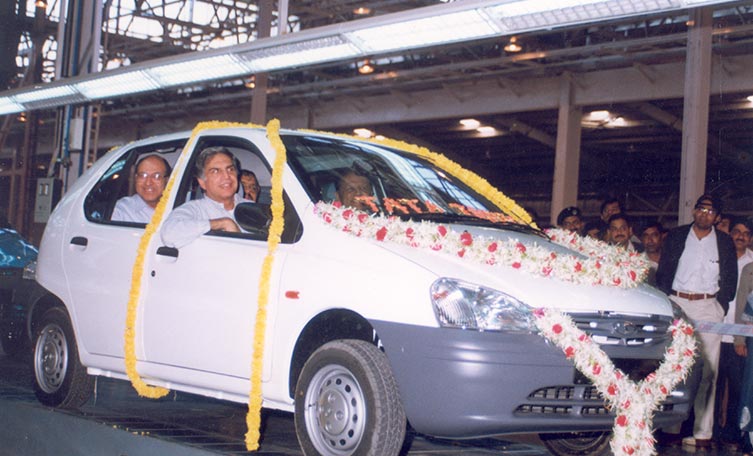December 2023 | 819 words | 3-minute read
A chilly breeze rolled over Pragati Maidan in New Delhi on January 15, 1998, but inside the packed-to-the-gills, acre-wide Tata Motors pavilion at the Auto Expo, the atmosphere was heavy with anticipation.
As the dome lifted in a flurry of lights, there was loud cheering from spectators, who were awestruck by the knockout of a car. It was a culmination of years of excitement that had swirled around the Indica (portmanteau for ‘India’s car’) project, dreamed up by Ratan N Tata, the then Chairman of Tata Sons, and currently Chairman Emeritus, Tata Sons, and Chairman, Tata Trusts.
His vision had captured the imagination of a newly liberalised India, and the country’s first indigenously designed car was now poised to disrupt the local automotive industry.
One of the reasons it was eagerly awaited was because it vowed to be the kind of car Indians had always wanted, but never been able to purchase. Back then, Indians had to settle for a car from a foreign brand — all built for their home markets, with outdated designs. In contrast, the Indica was tailor-made for the Indian family. Tatalog, by Harish Bhat, Brand Custodian, Tata Sons, quotes Mr Tata as saying, “We decided to design a car with the internal volume of an Ambassador, the size of a Maruti Zen… We thought of pricing it close to the Maruti 800, and adding the economy of diesel.”
The making of an icon
When the car was finally unveiled, it had everything that was promised — a roomy interior despite its compact size, the economic option of a diesel engine, and a host of features like air-conditioning, central locking, a five-speed gearbox and a tachometer, which were unavailable in the affordable car segment then. It was indeed ‘More car per car’.
Where the Indica truly shone, was in its sleek, stunning design — which surprised many, since the company had built its reputation in the commercial vehicle and utility vehicle space. This breakthrough was led by Mr Tata himself. The Engineering Research Centre in Pune finalised designs in collaboration with I.DE.A, an Italian company renowned for designing the Alfa Romeo 155 and Ferrari Mondial. Further, the team worked with Le Moteur Moderne in France to test the transmission system (designed entirely in-house), produced car seats in a JV with Johnson Controls in the US, and rear-view mirrors in partnership with Ficosa in Spain. But 98% of the Indica’s 3,885 components were made in India — a staggering statistic for a country that had never manufactured its own passenger vehicle (PV). This was made possible by 300+ component vendors the company had developed, and, not least of all, by Tata AutoComp Systems. The effort paid off. The car had 1.15 lakh fully paid bookings within eight days of launch; an unprecedented number for any car then.

A legacy of innovation
In the 25 years since its launch, the Indica — and the imagination and pioneering initiative that went into its creation — has served as a launchpad for Tata Motors’ PV business and for India’s automotive sector. “Tata Indica was a game changer for the Indian automobile industry because it was not only India’s first indigenously developed car but also represented something larger — a significant step forward in India’s journey to building home-grown competencies for making vehicles of the future,” says Shailesh Chandra, Managing Director, Tata Motors Passenger Vehicles and Tata Passenger Electric Mobility. “Indica’s innovativeness, design and localisation outlined Tata Motors’ broad vision as it forayed into the PV segment. Conceived to meet the needs of the Indian customer, Indica quickly grabbed the numero uno spot in the market and set the stage for Tata Motors to seriously develop its PV portfolio.”

In the following years, the company unveiled competitive, segment-defining and hugely popular cars like the Tata Indigo and Tata Nano in quick succession. The current PV portfolio features popular cars like the Nexon – India’s #1 SUV, Punch and Tiago, among others — all leaders in their segments. The company has also become the pioneer of the EV revolution in India, with the launch of the Nexon EV, India’s own electric SUV.
Tata Indica made many of these milestones possible by establishing an environment conducive to indigenous manufacturing with a robust supply chain and a conviction in India’s engineering prowess in developing globally competitive products. This was a goal articulated by Mr Tata, as quoted in Tatalog: “Can we do something that has never been done before? I would like to believe that it can be done… I hope the younger generation will take India to new heights… They need to believe in and recognise the potential of their own capabilities.”
—Anuradha Anupkumar































